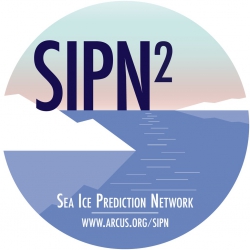By: Betsy Turner-Bogren, ARCUS Project Manager

The Sea Ice Prediction Network–Phase 2 (SIPN2) is a network of U.S. and international members working to advance research on the processes driving sea ice predictability, the production of operational products, and the communication of findings to interested stakeholders. With funding provided by NSF-Arctic Sciences Section and the U.K. Natural Environment Research Council (NERC) and additional support and in-kind contributions by several organizations, SIPN2 efforts commenced in early 2018 and will continue through 2022.
Recent SIPN2 Activities
2018 Sea Ice Outlook Reports
The Sea Ice Outlook (SIO ) provides an open process for those interested in Arctic sea ice to share ideas. It is a community network activity led by the Sea Ice Prediction Network-Phase 2 (SIPN2) Project Team with contributions from key partners.
The 2018 Interim SIO Post-Season Report was published in early October 2018. This report provided a quick post-season update to summarize how the outlooks did in comparison to the observed minimum extent. The September monthly averaged sea ice extent was 4.71 million square kilometers, based on the National Snow and Ice Data Center (NSIDC) Sea Ice Index. The median extent of the 39 Outlook contributions for June, July, and August were 4.60, 4.70, and 4.57 million square kilometers, respectively.
The 2018 Full SIO Post-Season Report was published in mid-March 2019. This report included an in-depth analysis of factors impacting sea ice this season. It centered around forecasts of pan-Arctic September minimum sea ice extent, while also including information about forecasts of sea ice probability and a synthesis of observed Arctic conditions from June to September 2018. It also included a review of forecasts for the Alaskan sector; an evaluation of the SIO forecast skill; discussions about Antarctic maxima sea ice extent forecasts; the Sea Ice Drift Forecast Experiment; an overview of sea ice forecasting needs of the Alaska marine shipping industry; and ideas of how to continue efforts to understand sea ice predictability and how to create information products that are accessible to stakeholders so that the science can be used in decision making to improve outcomes.
SIO 2019 season launched with the Call for Contributions for the 2019 June report. Pan-Arctic and Regional Sea Ice Extent Outlooks and any additional figures and gridded fields will be accepted for the 2019 June Outlook. We particularly encourage submissions for the Alaska region (i.e., Bering, Chukchi, and Beaufort seas). For those interested, submissions for Hudson Bay are also accepted. Submissions that include spatial forecast maps are encouraged.
Outreach Activities
SIPN2 convened an Open Community Meeting on 11 December during the 2018 Fall Meetings of the American Geophysical Union. This meeting was organized to promote knowledge exchange and collaboration among members of sea ice research community. Meeting participants were invited to share brief updates about their projects/efforts related to sea ice prediction and/or observations. A brief overview of the 2018 Arctic sea ice/Sea Ice Outlook season was also provided.
The first event of the 2019 SIPN2 webinar series was held on 25 April 2019. The presentation entitled "ICESat-2 over Sea Ice: Early Results" featured Ron Kwok, NASA Jet Propulsion Laboratory and ICESat-2 Team. The presentation focused on one of NASA's science objectives for the ICESat-2 altimetry mission—to provide observations to quantify changes and to add to previous satellite and airborne records of freeboard, thickness, and sea surface height of the ice-covered Arctic and Southern Oceans. Webinar presentations are archived on the SIPN2 website.
Further information about SIPN2 and the Sea Ice Outlook (SIO) is available on the SIPN2 Meetings/Webinars website.
For questions, contact Betsy Turner-Bogren, ARCUS (betsy [at] arcus.org).
About the Author
 Betsy Turner-Bogren is a Project Manager at ARCUS who provides staff support to the SIPN2 project and its team members. She also manages the NSF-supported publications Witness the Arctic and Witness Community Highlights.
Betsy Turner-Bogren is a Project Manager at ARCUS who provides staff support to the SIPN2 project and its team members. She also manages the NSF-supported publications Witness the Arctic and Witness Community Highlights.
